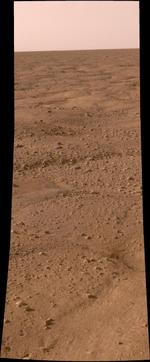Twenty-one hours ago, the space probe Phoenix landed on Mars, and NASA has already released some images. Looking at them, somewhat blearily, this morning, I felt almost frightened. This is what I would see if I were stranded on Mars, I realized, and the realization had uncanny force. Red dirt and rubble for miles and miles. I couldn’t figure out why the photos were so powerful. I’d looked at lots of pictures from the Mars Pathfinder and its sidekick, the Sojourner Rover. How come they had never hit me in the pit of my stomach?
Later in the day the answer came to me: the Phoenix photo (left) had been taken from a camera roughly as high off the ground as my eyes are. That was my subjective and retrospective impression, anyway, and double-checking just now, it seems to be the case. The Phoenix’s Surface Stereo Imager, which took this picture, sits on a mast that puts it “two meters above the ground, roughly the height of a tall person,” according to the NASA website. The mast for the Mars Pathfinder’s Imager, by contrast, only hoisted it about a meter off the ground. And the Rover snuffled along with a turtle’s-eye view. If I were a toddler, maybe the Pathfinder’s pictures would have a stronger effect on me, but as it is, the Phoenix is more likely to get under my skin.
This insight came to me on the subway, where I had idly noticed a grade-school-age girl watching an animated movie on her I-Pod while her parents, on either side of her, read a paper edition of the New York Times. Her tiny screen kept flickering, as the movie jump-cut from one viewing angle to another. I think that’s what made me realize that it was the viewing angle of the space probe that brought its picture home to me. The flickering also made me think of a 1929 movie I had tried to watch last week, a Maurice Chevalier vehicle called Love Parade, a crashing bore that I gave up on after an hour. The one thing I had liked about it was how primitive its cutting was: the camera was for the most part just planted in front of the actors, who sang and danced before it in takes that lasted minute upon leisurely minute. The implied viewer, after all, was a theatergoer, accustomed to sitting in his seat for hours. Who (I next wondered) is the implied viewer of a modern movie, with all its cuts and jumps? The viewpoint assembled from the multiple camera angles moves much faster than any of the actors—faster, in fact, than any single human being could move—so fast that the implied viewer of a contemporary movie can’t be an individual at all. It has to be a crowd, which is in more than one place at a time. You watch a modern movie as if your self were a group of people. No doubt film theorists figured this out long ago, but it was news to me, and a bit disturbing. Suddenly solitude on Mars seemed almost homey.


I've had a sortof similar experience. I saw this http://math.ucr.edu/home/baez/mars_sunset.jpg image on The Daily Dish a while back, thought it was cool, and made it my wallpaper. (Previously I'd had http://en.wikipedia.org/wiki/Image:Milky_Way_IR_Spitzer.jpg.) The change caused me to forget my Windows password, which I'd used daily for three years. I've come to realise that something I can't get a conscious fix on — something inside me — finds it profoundly unsettling. Out of psychological interest I've kept it. Now, every small second before I know I'm going to see it, I feel dread. It's very hard to stare at.
GS: That is a terrifically unsettling image. Currently my own comfy and unchallenging computer wallpaper is a rotating set of jpegs of British railway posters, filched from the the online catalog for a June 25 auction at Onslows. Maybe this is the sort of Anglophilia that only an American can go in for, though. Also pleasant and earthly: old U.K. photo postcards.